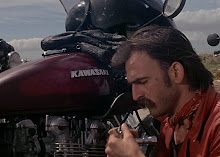Many things come to mind when Russia is thought about: Communism, Tsars, hockey, extremely cold weather. Maybe bad guys in James Bond movies come to mind.
But what about motorcycles?
Since 1940, the land that brought us Nikita Khrushchev, Pyotr Romanov and Valeri Kharlamov has been manufacturing motorcycles as well.
The Russian motorcycles industry started with five BMW R71s covertly purchased by the Soviet government through Swedish mediators. The BMWs were then brought back to Moscow were they were reverse engineered (i.e. taken apart and copied) by Soviet engineers. The BMW R71 was a ruggedly simple motorcycle and had served the German army well in WWII.
The Soviets wanted a sturdy and highly mobile vehicle and the specifications of the R71 fit the Soviet's needs to a tee. For the R71, BMW took their air-cooled flat twin-cylinder engine, mounted it in a full steel frame and put a shaft final-drive out back.
The cylinder heads stuck out of the frame which aided in engine cooling and longetivity, and the shaft final-drive negated the need for a chain and thus was easier to maintain. The solid steel frame meant the design was very strong and could take the abusive Russian landscape with ease.
In the early part of 1941, the prototype M-72 motorcycle was shown to Josef Stalin and he cleared the motorcycle for production. The motorcycles were intially produced in Moscow but fears of German bombs caused the Soviets to move production to Irbit in the Ural mountains. Production was split between the Irbit Motorcycle Works (IMZ) plant in Irbit and the Gorkiy Motorcycle Plant (GMZ) in the Ukraine. In total, about 10,000 M-72s were produced for the war effort.
During the fifties, the GMZ plant took over war production and the IMZ plant concentrated on civilian models. Motorcycles produced at the IMZ plant were intially sold to developing countries and were branded as IMZ-Ural. The GMZ plant eventually sold their own civillian version of the M-72 under the brand name Dnepr.
Both of these brands sold the majority of their motorcycle equipped with sidecars and even offered two-wheel drive to combat the poor quality of Russian roads. Most of the Ural and Dnepr models are sold within Russia but they do export to Europe, North and South America, Australia and the Middle East.
Ural is by far the largest Russian motorcycle company. Not much has changed in the models offered by Ural since the design of the original M-72. The engine was stroked from the original 650cc to 750cc and electronic fuel injection was added to help meet U.S. EPA requirements. Other major components were sourced from reputable companies. The alternator is from Nippon Denso, the brakes are from Brembo, the forks are from Paoili and the electronics are from Ducati Energia.
All of the models offered in the U.S. come equipped with a sidecar. Ironically, an American-cruiser-style model without a sidecar is offered in other countries. The base Ural-T starts at $9,999 and comes in stylish black paint with red pinstripes. See, and you thought the Russians had no sense of style.
The real party-piece is the two-wheel drive Patrol.
With the flick of a lever, the wheel on the sidecar is engaged and you can now conquer the expanses of Siberia, the vast forests of Tunguska or that snow-covered field across from your house. The Patrol starts at $12,399. It even comes in camo paint.
That may seem like a lot for a motorcycle that isn't very fast or good-looking but it isn't. Sidecars range in price from $3,000 to $6,000. Add in the cost of a motorcycle and you can easily cross the $12,000 barrier. Not only that but you have to get the car attatched and aligned correctly. With a Ural, it's all done for you. All you have to do is get on.
A Ural really is a time piece.
It's a very simple and rugged machine, much like everything else born in Russia. The Russians cannot claim to make the quickest, the highest-tech or the most beautiful motorcycles in the world. The can, however, claim to make the most rugged and really, that's what they needed. Much like the MiG-1, the ZAZ-968 or the Kliment Voroshilov tank, the Ural is built to be simple and effective.
Plus, they're really cool.
The rugged M-72. Every motorcycle should come equipped with a gun holster.
The Ural-T is pretty sharp. It looks a bit menacing. Compared to the M-72 above, it really doesn't look that much different, though.







